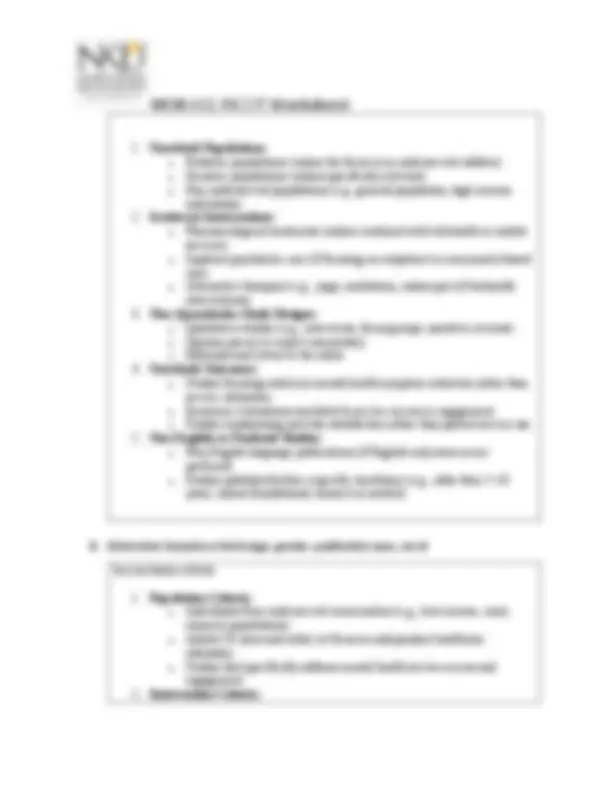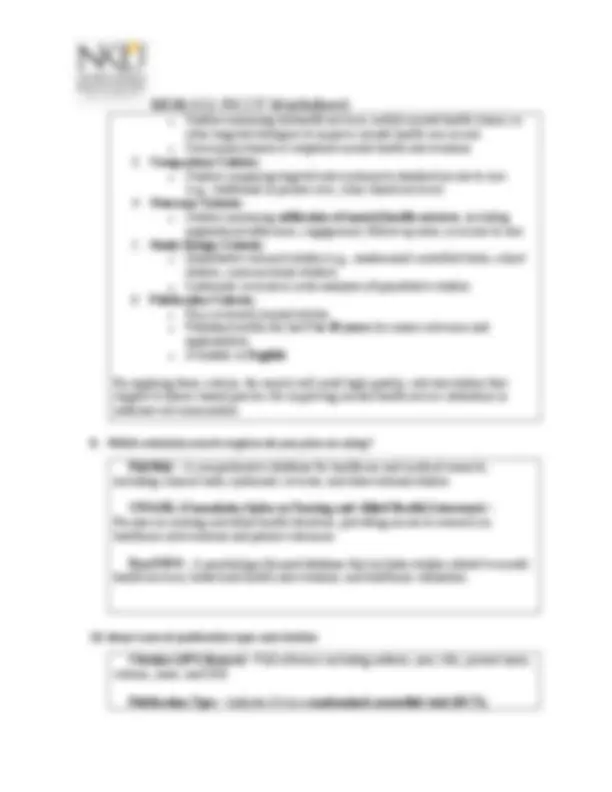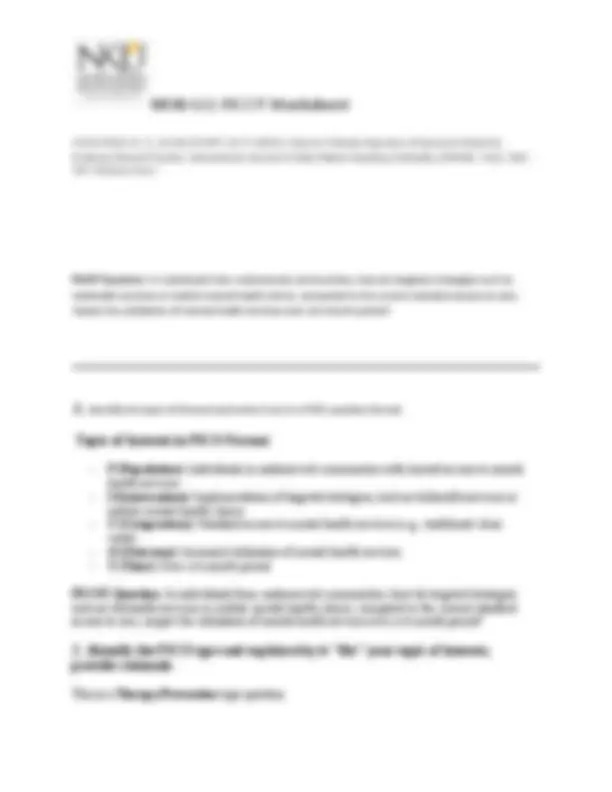Download Northern Kentucky University MSN 602| MSN602 PICOT Worksheet_Answered Correctly 2025/26. and more Exams Nursing in PDF only on Docsity!
Part I Query
Think about a topic of interest or problem that is of interest.
1. Identify your problem using the PICOT: Patient/Problem - Who is your patient? (Disease or Health status, age, race, sex): Individuals in underserved communities with limited access to mental health services. Intervention- What do you plan to do for the patient? (Specific tests, therapies, medications) : Implementation of targeted strategies, such as telehealth services or mobile mental health clinics. Comparison - What is the alternative to your plan? (i.e., No treatment, different type of treatment, etc.): Standard access to mental health services (e.g., traditional clinic visits). Outcome - What outcome do you seek? (Less symptoms, no symptoms, full health, etc.): Increased utilization of mental health services. Time - What is the time frame? (This element is not always included.): Over a 6 - month period 2. Next, write out the PICO in a question format: Your PICOT question will fall under one of these types: Therapy/Prevention Diagnosis Etiology Prognosis
- Identify the PICO question type (depends on what and how the question is formulated) This is a Therapy/Prevention type question. Why it fits: The question is designed to evaluate the effectiveness of an intervention (targeted strategies) aimed at improving health outcomes (increased service utilization) In individuals from underserved communities, how do targeted strategies such as telehealth services or mobile mental health clinics, compared to the current standard access to care, impact the utilization of mental health services over a 6 - month period?
in a specific population. It seeks to assess whether the proposed strategies prevent gaps in mental health service access. 4. ☒Therapy (best treatment for interventions) ☒Prevention (Prevent this problem) ☐ Diagnosis/Assessment ( best way to assess or diagnostic test for patient) ☐ Causation ( cause of the problem) ☐ Prognosis ( long term effects of the problem) ☐ Meaning (meaning of the experience to the patient’s)
5. Once the PICO type is identified,it is easier to determine the type of primary research that is specific to the type pf clinical question
Part II PICO search
**6. Identify terms/topics from PICO that can be searched
- What terms might you exclude from your search?** Therapy: Randomized controlled trials (RCT), Controlled trials Prevention: Randomized controlled trials (RCT), Controlled trials Diagnosis/Assessment: Instrument development research Causation: Cohort, Case control, Descriptive, or Qualitative studies Prognosis: Cohort or descriptive studies. Meaning: Qualitative studies (P) Underserved communities, Low-income populations, Rural populations, Minority groups, Vulnerable populations, Individuals with limited healthcare access (I): Targeted strategies, Telehealth services, Telemedicine, Mobile mental health clinics. Community-based mental health programs, Digital mental health interventions (C): Standard access to care, Traditional mental health services, In-person mental health care, Usual care models (O): Utilization of mental health services, Access to mental health care, Appointment adherence, Mental health service engagement, Patient follow-up rates, Treatment compliance Potential terms to exclude include:
**9. Which scholarly search engines do you plan on using?
- Keep track of publication type and citation** o Studies examining telehealth services, mobile mental health clinics, or other targeted strategies to improve mental health care access o Community-based or outpatient mental health interventions
- Comparison Criteria: o Studies comparing targeted interventions to standard access to care (e.g., traditional in-person care, clinic-based services)
- Outcome Criteria: o Studies measuring utilization of mental health services , including appointment adherence, engagement, follow-up rates, or access to care
- Study Design Criteria: o Quantitative research studies (e.g., randomized controlled trials, cohort studies, cross-sectional studies) o Systematic reviews or meta-analyses of quantitative studies
- Publication Criteria: o Peer-reviewed journal articles o Published within the last 5 to 10 years (to ensure relevance and applicability) o Available in English By applying these criteria, the search will yield high-quality, relevant studies that support evidence-based practice for improving mental health service utilization in underserved communities. PubMed – A comprehensive database for healthcare and medical research, including clinical trials, systematic reviews, and observational studies. CINAHL (Cumulative Index to Nursing and Allied Health Literature) – Focuses on nursing and allied health literature, providing access to research on healthcare interventions and patient outcomes. PsycINFO – A psychology-focused database that includes studies related to mental health services, behavioral health interventions, and healthcare utilization. Citation (APA format) – Full reference including authors, year, title, journal name, volume, issue, and DOI. Publication Type – Indicate if it is a randomized controlled trial (RCT),
CAULFIELD, E. V., & VALCOURT, M. P. (2021). How to Critically Appraise a Research Article for Evidence-Based Practice. International Journal of Safe Patient Handling & Mobility (SPHM) , 11 (2), 100 –
- Retrieve from : PICOT Question: In individuals from underserved communities, how do targeted strategies such as telehealth services or mobile mental health clinics, compared to the current standard access to care, impact the utilization of mental health services over a 6-month period?
.1. Identify the topic of Interest and write it out in a PICO question format.
Topic of Interest in PICO Format
- P (Population): Individuals in underserved communities with limited access to mental health services.
- I (Intervention): Implementation of targeted strategies, such as telehealth services or mobile mental health clinics.
- C (Comparison): Standard access to mental health services (e.g., traditional clinic visits).
- O (Outcome): Increased utilization of mental health services.
- T (Time): Over a 6 - month period. PICOT Question: In individuals from underserved communities, how do targeted strategies such as telehealth services or mobile mental health clinics, compared to the current standard access to care, impact the utilization of mental health services over a 6-month period?
2. Identify the PICO type and explain why it "fits" your topic of interest,
provide rationale.
This is a Therapy/Prevention type question.
This model aligns well with the project's goal of improving access to mental health care and guiding practical, patient-centered solutions for underserved populations.














